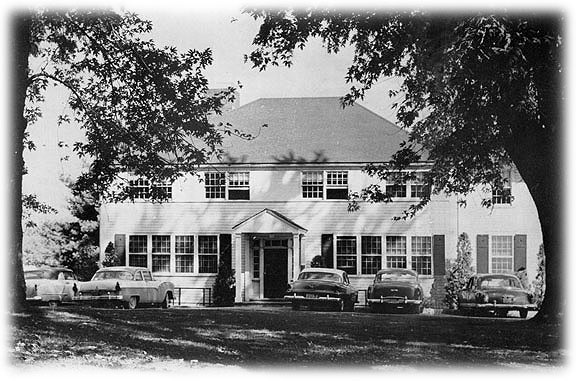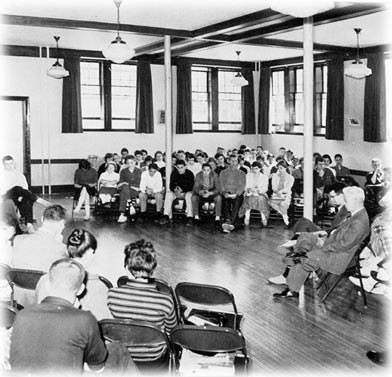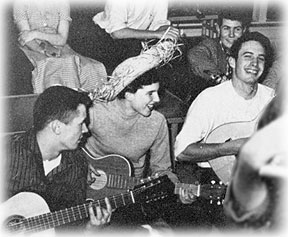JONATHAN TALBOT
REFERENCE POINTS - AN ARTISTIC CHRONOLOGY IN PROGRESS
1955-57 - Oakwood Friends School
 |
|
The Main Building at Oakwood Friends School as it appeared in 1957, JT's senior year. It still looks the same over fifty years later. Only the cars have changed. |
Oakwood
Friends School, the school of New York Yearly Meeting of the Society
of Friends (Quakers), held it first classes in 1796 and is arguably
the oldest co-educational independent secondary school in the United
States. JT spent his junior and senior years of high school there. Life at Oakwood in 1955-57 was out of sync with its time. Social activity was limited to holding hands between 7 and 7:30 PM and infractions were likely to result in expulsion. Drinking and smoking were completely prohibited. Jackets and ties were required attire at dinner. But Oakwood was also out of sync in some very positive ways. While segregation was still the law in many parts of the United States in 1957 and African Americans could not use the same water fountains as whites in the nation's capital, Oakwood, in keeping with its Quaker roots, refused to allow discrimination of any kind on the basis of race or gender. This had both bittersweet and tragic consequences during JT's years there. The bittersweet was that Oakwood students were specifically advised that when they left campus they were to act differently than they did on school grounds. Specifically, they were advised to restrain their behavior lest they demonstrate too much friendship with those of their schoolmates who were not of the same color. The tragic was that one Oakwood parent, noted actor James Cagney, came to see his daughter perform in the school play and, arriving before the performance, found her holding hands with a boy with substantially darker skin than her own. Cagney, true to form, immediately withdrew his daughter from the school and protested to the school's board. Because of Cagney's wealth and national prominence, his actions carried unmerited weight and the members of Oakwood's Board of Managers were divided about how to respond. In the face of this division, Oakwood's cherished headmaster, William Clark, resigned his position in protest. But even tensions such as these were part of JT's education there. Despite its conservative
Quaker views of what was, and what was not, acceptable behavior for
young people, Oakwood was basically a liberal school. Among Oakwood's
long list of distinguished commencement speakers were Eleanor Roosevelt
and Ralph Bunch and while blacklisting by the likes of Joseph McCarthy
prevented folksinger Pete Seeger from performing almost everywhere,
Oakwood invited him to perform at the school twice during JT's years there. |
||
Attendance at Quaker Meeting for Worship was required. Twice a week students, faculty and staff gathered to spend forty-five minutes to an hour in mostly-silent contemplation. Anyone who felt moved to share something verbally with those assembled was free to do so but the silence was powerful and somewhat intimidating and comments were minimal. Meeting was, instead, a time for reflection, centering, and meditation. As a high school student JT was less interested in the plastic arts than in mathematics and physics. These sciences appealed to him because he believed that they offered "absolute" truths. Oakwood, however, unwittingly informed him otherwise and directed his life's course away from those subjects and towards the arts... The first shift of the compass occurred in 1956 during JT's junior year at Oakwood. Inspired by his classmate Jody Adler, a mathematical genius, JT taught himself binary mathematics. In one of his classes JT studied Suzanne Langer's Introduction to Symbolic Logic. Putting "10 and 10 together," JT built his first digital computer. Because simple transistors had not yet been invented, his computer was made of large banks of hard-wired relays and it took up considerable space. When the project came to the attention of his teachers, JT was called to a faculty meeting where it was explained that the primary use of computers was to aim weapons and his efforts were, therefor, not an appropriate activity at a school run by the Society of Friends, a religion which includes pacifism among its primary tenets. JT pointed out that his computer did little more than beat or tie everyone at tic-tac-toe but his arguments were of no avail and the first and last "Talbot Mainframe" was soon disassembled. The lesson JT learned (a lesson which he has since determined was false) was that science was immoral. |
 Silent Meeting for Worship at Oakwood - 1957 |
|
The second change of course took place the following year. At Oakwood, all seniors were required to write a short thesis in each of their subjects. This thesis had to consist of new research rather than a discussion of material which had already been studied. JT selected Quantum Theory as his topic for Physics. This turned out to be a life-defining choice because, since JT didn't have access to the most recently published scientific journals, he failed to comprehend the manner in which quantum mechanics accounts for the wave-particle duality and the uncertainty involved in both empirical and imaginary experiments. But he did learn that Physics and Mathematics are no more "absolute" than music or art and he chose to make that epiphany the focus of his thesis. Regrettably, his physics teacher, Terrell Gardner, was not impressed. Gardner, who favored authoritarianism rather than nurturing, resented JT's ambition. JT's thesis gave him an opportunity to "get even." He marked it "unacceptable" and, while he could not fail JT because he had done well in the rest of the course, Gardner gave JT the only "D" he ever received during his schooling. That "D,": however, was enough to keep JT out of all of the colleges to which he had applied. As a result, 1961 found JT leading hootenannies at the Cafe Wha? in Greenwich Village instead of graduating from college. Despite the inverted nature of some of what what he learned there, JT's dedication to Oakwood has remained strong. As an adult he sent both his children to Oakwood and he also served for five years on Oakwood's Board of Managers. JT has written of being grateful to Oakwood for the formal education it provided, for the manner in which it encouraged independent thinking, for the sense of social responsibility which was an important part of the Oakwood community, and for having taught him those humanistic Quaker principles which became the fulcrum on which he has balanced his life for the past half-century. |
||
 An Oakwood Snapshot from 1957. JT is on the right. The other singers are JT's classmates Dave Williams and Susan Wright. Behind JT is Bard Prentiss who painted the first painting JT ever purchased. |
The
Oakwood Friends School website |
All written material on this page is Copyright © 2010-2012 by Jonathan Talbot and may not be reproduced by any means, priunted, electronic or digital, without the express written permission of Jonathan Talbot